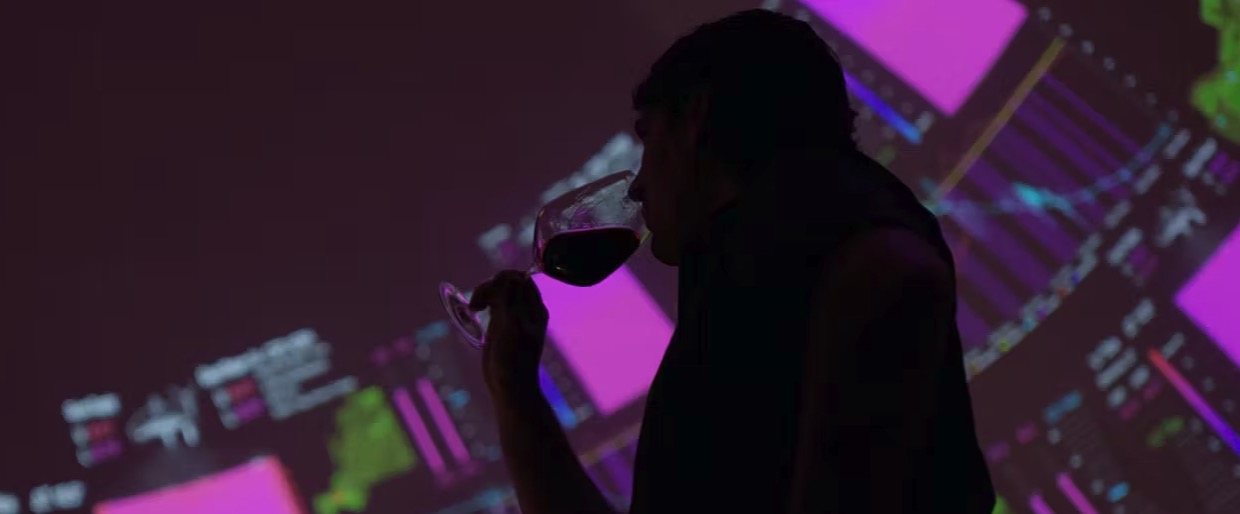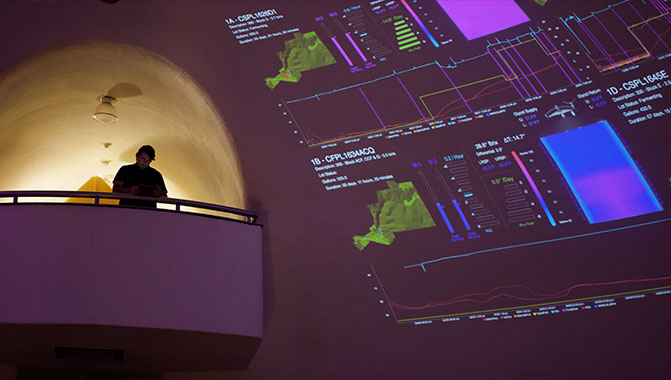
Napa Winery Uses Projections To Visualize Data On Fermentation Room Dome
August 10, 2023 by Dave Haynes
Real-time data visualization as dashboards are increasingly common use-cases for digital signage technology in production environments but a wine producer in California’s Napa region is using it in a very interesting way – projecting the data coming from its fermentation tanks on the ceiling of the room where they’re operating.
Six Christie laser projectors are showing visuals on the fermentation dome of Palmaz Vineyards.
From Christie:
Palmaz Vineyards spans 600 acres and features an 18-story winemaking facility that has been built into Napa’s Mount George, with over five city blocks of tunnels that have been dug underground.
At the heart of the winery is the fermentation dome that houses 24 fermenting tanks on a carousel. The grapes from the vineyards are transported here to be fermented into wine during a delicate and intensive 60-day process.
“It’s a complicated process – the fermentation is exothermic which produces heat, so the temperature is constantly adjusted. It’s a complex equation. But this is something that any first-year enology grad student can do. So why work with the very best winemakers as we do? Because of the other things that you can’t put numbers to,” says Christian Palmaz, COO, Palmaz Vineyards.
Palmaz wanted to strike a balance between the creativity needed to develop their award-winning wines, and the data to inform the process of fermentation. They created a software system called Fermentation Intelligence Logic Control System (FILCS) which takes millions of calculations per second from inside each tank.
Instead of limiting this robust amount of data to an app on a tablet or desktop, Palmaz Vineyards decided to make this information available to its team of winemakers via projections on the ceiling of the fermenting room to enable a collaborative process.
“We wanted something that worked for them [the winemakers] and we wanted to make it hands-free. We didn’t want them living on a screen; it’s isolating. We had the idea to put all of that information on the surface of the dome. That’s when I started looking into projection technology,” says Palmaz.
“I happen to be a pilot, and during my annual training, I was in a flight simulator and wondered how they got this perfect curved and blended image. I walked around to the front of the simulator, and lo and behold I see six or seven Christie projectors,” says Palmaz. “I called Christie the next day, and we got to work.”
Palmaz originally installed Christie M Series projectors. “We needed a huge amount of clarity, brightness, and durability. We used the original M Series for over a decade and then upgraded to the M 4K25 RGBs for even more brightness. They are incredibly bright.” The increased brightness of the projectors also allows the Vineyard to run the room with more lighting, ensuring a safer work environment.

RFID sensors on each tank can identify which winemaker is in front of the tank and display customized data on the domed ceiling.
“Color is really important,” says Palmaz. “Because of our thermographic displays, color means something to us. Seeing the dynamic color effect – as the temperatures change when pump-overs occur – it’s like varying shades of bathwater. You’re talking about a 5–6-degree change in temperature in the tank. But the range of color [that the projectors display] helps to visualize slight variations in temperature.”
“It’s something we noticed with the newer projectors, they have such a wide color gamut and better color accuracy. It translates to us having a better understanding of the temperature and how it’s distributed inside the tank,” says Palmaz.
This is, I think, the key line: Instead of limiting this robust amount of data to an app on a tablet or desktop, Palmaz Vineyards decided to make this information available to its team of winemakers via projections on the ceiling of the fermenting room to enable a collaborative process.
I don’t know a lot about winemaking (but I’m a power-user on the consumption side!). However it strikes me that winemakers don’t spend a lot of time in a control room staring at dashboards. Having analytics and KPIs ever-present right in the production rooms means they can just look up and see what’s going on.
And it probably adds a little showmanship on tasting tours, assuming they do that.



Leave a comment